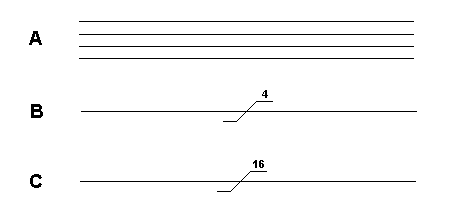| A bus is a collection
of wires.
Diagram A is
a four bit bus.
Zeros and ones
can be put on the bus, 0 volts for zero and +5 volts to represent a one.
The smallest
number that can be put on a four bit bus is 0000.
The largest
is 1111 which is 15 in decimal and F in hex.
Therefore sixteen
different numbers can be placed on this bus, 0000 being the lowest and
1111 the highest.
Rather than draw
four wires,we use the representation shown in diagram B.
Many micoprocessor
systems use a eight bit data bus.
The smallest
number that can be placed on it is 00000000.
The largest
number is 11111111 which is equivalent to 255 in decimal.
Therefore 256
different numbers can be placed on this bus.
255 in decimal
is FF in hex.
A sixteen bit
bus is shown in diagram C.
The smallest
number we can put on this bus is 0000000000000000.
The largest
number is 1111111111111111 which is 65535 in decimal.
Therefore 65536
different numbers can be put on this bus.
65535 in decimal
is FFFF in hex.
All the registers
in the memory chips have their own individual addresses, like house numbers
in a street.
By putting its
address, in binary, on an address bus we can select any individual register.
Address buses
are commonly 16 bits, so we can select any one of 65536 registers. |


